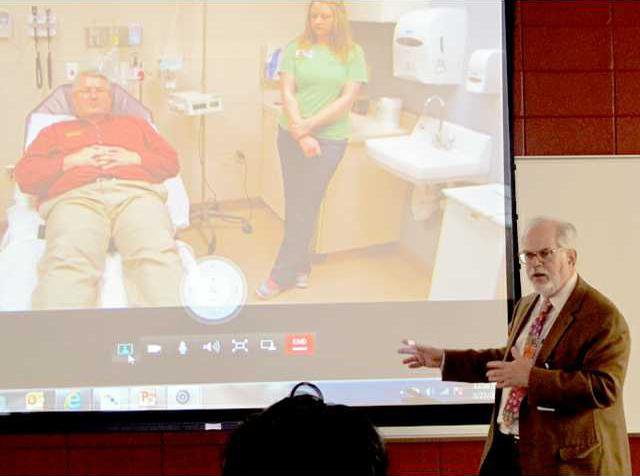Stroke is a “brain attack,” and the fourth-leading cause of death. About 795,000 strokes occur each year. One occurs every 40 seconds, taking a life about every four minutes. Two million brain cells die every minute during stroke. Women are twice more likely to die from stroke than from breast cancer annually.
These were some of the sobering statistics Liberty County Chamber of Commerce members heard from neurologist Dr. Joel Greenberg, co-medical director of Memorial Health University Medical Center’s stroke program, during a Progress Through People luncheon Thursday at the Liberty County Performing Arts Center.
Greenberg demonstrated how Telehealth — the delivery of health-related services using telecommunications and technology — can treat stroke patients from rural communities in the precious first hours when stroke treatment should be administered. Stroke telemedicine is a new partnership between Liberty Regional Medical Center and Memorial Health.
There are two types of strokes, hemorrhagic or ischemic, according to the American Stroke Association. “An ischemic stroke occurs as a result of an obstruction within a blood vessel supplying blood to the brain,” strokeassociation.org states. This type of stroke accounts for 87 percent of all stroke cases, the website states. “A hemorrhagic stroke occurs when a weakened blood vessel ruptures and spills blood into brain tissue,” according to the stroke association.
Greenberg informed chamber members of the high risk of stroke faced by many Georgia residents due to factors including poor diet, sedentary lifestyles, high blood pressure, smoking, high cholesterol, obesity and diabetes.
This high risk of stroke, coupled with rural residents’ distance from hospitals where they would get immediate treatment, could lead to more deaths and permanent disability, he said.
This is where telemedicine can save lives, Greenberg said.
The neurologist demonstrated how he could examine a patient in a rural community, like Hinesville, using cameras and videoconferencing. He spoke to a nurse at the other end of the call and asked the mock patient to perform certain physical tasks — like gazing right and left and lifting an arm – to show how he would determine if stroke had occurred. A patient also would be asked to repeat words or phrases to assess any loss of language, which helps gauge the severity of the patient’s condition, Greenberg said.
The examining physician also has access to a patient’s history, lab work and any other tests via telemedicine, according to Greenberg.
If a neurologist examining a patient via telemedicine determines a patient has suffered a (ischemic) stroke, he or she would prescribe tPA (tissue plasminogen activator), the only Food and Drug Administration-approved stroke treatment administered intravenously, he said.
This medication is best administered to a stroke patient in the first 3-4.5 hours of the stroke, the neurologist said. He said tPA improves a patient’s chances for stroke recovery.
If a stroke has been diagnosed via telemedicine, then immediate arrangements for treating and transporting the patient to the hospital also can be made, Greenberg said. Memorial Health offers 24/7 stroke coverage via telemedicine, he added.
Greenberg urged chamber members to call 911 if they suspect a loved one is having a stroke. Signs of stroke include an uneven smile, weakness in the arm and slurred speech, he said.
Chamber hears of tele-medicine project


Sign up for our e-newsletters